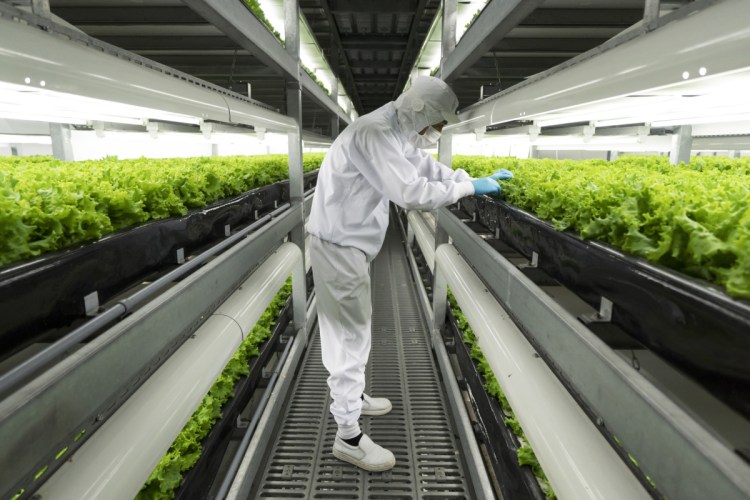High-rise indoor farms for vegetables are spreading across the world.
In a suburb of Kyoto in Japan, surrounded by technology companies and startups, Spread Co. is preparing to open the world’s largest automated leaf-vegetable factory. It’s the company’s second vertical farm and could mark a turning point for vertical farming – bringing the cost low enough to compete with traditional farms on a large scale.
For decades, vertical farms that grow produce indoors without soil in stacked racks have been touted as a solution to rising food demand in the world’s expanding cities. The problem has always been reproducing the effect of natural rain, soil and sunshine at a cost that makes the crop competitive with traditional agriculture.
Spread is among a handful of commercial firms that claim to have cracked the problem with a mix of robotics, technology and scale.
Its new facility in Keihanna Science City, known as Japan’s Silicon Valley, will grow 30,000 heads of lettuce a day on racks under custom-designed LED lights. A sealed room protects the vegetables from pests, diseases and dirt. Temperature and humidity are optimized to speed growth of the greens, which are fed, tended and harvested by robots.
“Our system can produce a stable amount of vegetables of a good quality for sale at a fixed price throughout the year, without using pesticides and with no influence from weather,” Spread President Shinji Inada, 58, said in an interview at the company’s existing facility in Kameoka.
Inada won the Edison Award in 2016 for his vertical-farming system. He expects the new factory, called Techno Farm, to more than double the company’s output, generating 1 billion yen in sales a year from growing almost 11 million lettuces.
About 60 percent of indoor-farm operators in Japan are unprofitable because of the cost of electricity to run their facilities, according to the Japan Greenhouse Horticulture Association. Most others only turn a profit because of government subsidies or by charging a premium to consumers for vegetables that are chemical-free. Spread sells lettuces for 198 yen a head to consumers, about 20 to 30 percent more than the normal price for conventionally grown varieties, according to Inada.
Consumers pay the premium because the pesticide-free vegetables are increasingly seen as an alternative to often more expensive organic foods, which must be grown outdoors in soil. Japan’s hot summers and high humidity also make organic plants more vulnerable to insects and diseases, said Yasufumi Miwa, an expert at the Japan Research Institute.
“Producing organic vegetables requires farmers’ extra-hard work and that should be reflected in the prices,” said Takumu Okuma, spokesman for online food supplier Oisix ra daichi Inc. “Pesticide-free vegetables are seen as safe by consumers and accepted by them as a substitute for more expensive organic ones.”
Small-scale vertical farms have been operating in Japan since the 1970s, niche players that took advantage of high prices for fresh food in cities in a nation that imports about 60 percent of its food. But it wasn’t until 2010, that the sector began to expand rapidly with the adoption of energy-saving LED lights and a government program to support innovative farming with subsidies, according to the association.
Spread’s Inada, a former vegetable trader, founded his company in 2006 and opened his first facility the following year in Kameoka city in Kyoto prefecture. The company spent years refining systems for lighting, water supply, nutrients and other costs.
Copy the Story LinkSend questions/comments to the editors.



Success. Please wait for the page to reload. If the page does not reload within 5 seconds, please refresh the page.
Enter your email and password to access comments.
Hi, to comment on stories you must . This profile is in addition to your subscription and website login.
Already have a commenting profile? .
Invalid username/password.
Please check your email to confirm and complete your registration.
Only subscribers are eligible to post comments. Please subscribe or login first for digital access. Here’s why.
Use the form below to reset your password. When you've submitted your account email, we will send an email with a reset code.